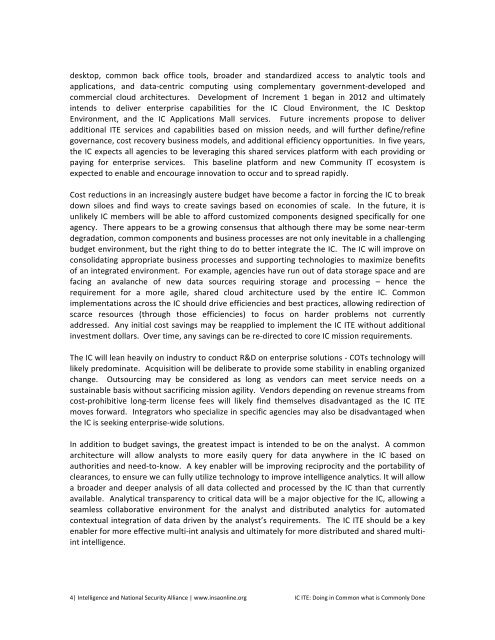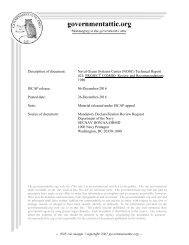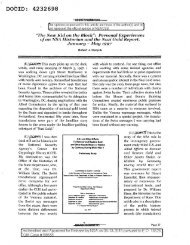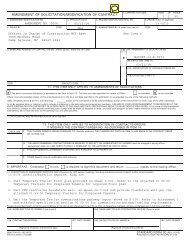insa-ic-ite
insa-ic-ite
insa-ic-ite
Create successful ePaper yourself
Turn your PDF publications into a flip-book with our unique Google optimized e-Paper software.
desktop, common back off<strong>ic</strong>e tools, broader and standardized access to analyt<strong>ic</strong> tools and <br />
appl<strong>ic</strong>ations, and data-‐centr<strong>ic</strong> computing using complementary government-‐developed and <br />
commercial cloud arch<strong>ite</strong>ctures. Development of Increment 1 began in 2012 and ultimately <br />
intends to deliver enterprise capabilities for the IC Cloud Environment, the IC Desktop <br />
Environment, and the IC Appl<strong>ic</strong>ations Mall serv<strong>ic</strong>es. Future increments propose to deliver <br />
additional ITE serv<strong>ic</strong>es and capabilities based on mission needs, and will further define/refine <br />
governance, cost recovery business models, and additional eff<strong>ic</strong>iency opportunities. In five years, <br />
the IC expects all agencies to be leveraging this shared serv<strong>ic</strong>es platform with each providing or <br />
paying for enterprise serv<strong>ic</strong>es. This baseline platform and new Community IT ecosystem is <br />
expected to enable and encourage innovation to occur and to spread rapidly. <br />
Cost reductions in an increasingly austere budget have become a factor in forcing the IC to break <br />
down siloes and find ways to create savings based on economies of scale. In the future, it is <br />
unlikely IC members will be able to afford customized components designed specif<strong>ic</strong>ally for one <br />
agency. There appears to be a growing consensus that although there may be some near-‐term <br />
degradation, common components and business processes are not only inevitable in a challenging <br />
budget environment, but the right thing to do to better integrate the IC. The IC will improve on <br />
consolidating appropriate business processes and supporting technologies to maximize benefits <br />
of an integrated environment. For example, agencies have run out of data storage space and are <br />
facing an avalanche of new data sources requiring storage and processing – hence the <br />
requirement for a more agile, shared cloud arch<strong>ite</strong>cture used by the entire IC. Common <br />
implementations across the IC should drive eff<strong>ic</strong>iencies and best pract<strong>ic</strong>es, allowing redirection of <br />
scarce resources (through those eff<strong>ic</strong>iencies) to focus on harder problems not currently <br />
addressed. Any initial cost savings may be reapplied to implement the IC ITE without additional <br />
investment dollars. Over time, any savings can be re-‐directed to core IC mission requirements. <br />
The IC will lean heavily on industry to conduct R&D on enterprise solutions -‐ COTs technology will <br />
likely predominate. Acquisition will be deliberate to provide some stability in enabling organized <br />
change. Outsourcing may be considered as long as vendors can meet serv<strong>ic</strong>e needs on a <br />
sustainable basis without sacrif<strong>ic</strong>ing mission agility. Vendors depending on revenue streams from <br />
cost-‐prohibitive long-‐term l<strong>ic</strong>ense fees will likely find themselves disadvantaged as the IC ITE <br />
moves forward. Integrators who specialize in specif<strong>ic</strong> agencies may also be disadvantaged when <br />
the IC is seeking enterprise-‐wide solutions. <br />
In addition to budget savings, the greatest impact is intended to be on the analyst. A common <br />
arch<strong>ite</strong>cture will allow analysts to more easily query for data anywhere in the IC based on <br />
authorities and need-‐to-‐know. A key enabler will be improving reciprocity and the portability of <br />
clearances, to ensure we can fully utilize technology to improve intelligence analyt<strong>ic</strong>s. It will allow <br />
a broader and deeper analysis of all data collected and processed by the IC than that currently <br />
available. Analyt<strong>ic</strong>al transparency to crit<strong>ic</strong>al data will be a major objective for the IC, allowing a <br />
seamless collaborative environment for the analyst and distributed analyt<strong>ic</strong>s for automated <br />
contextual integration of data driven by the analyst’s requirements. The IC ITE should be a key <br />
enabler for more effective multi-‐int analysis and ultimately for more distributed and shared multi-int<br />
intelligence. <br />
4| Intelligence and National Security Alliance | www.<strong>insa</strong>online.org IC ITE: Doing in Common what is Commonly Done
















